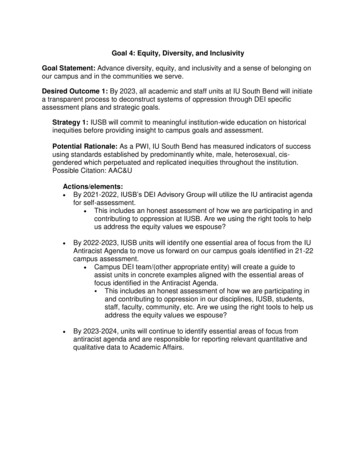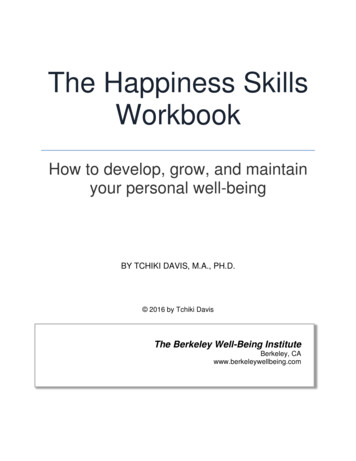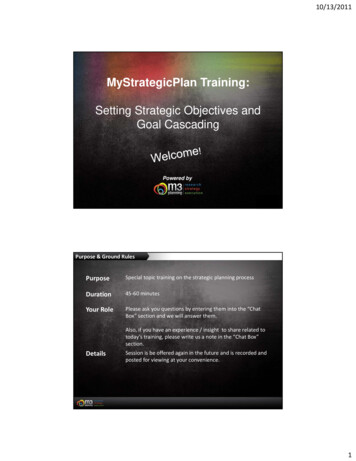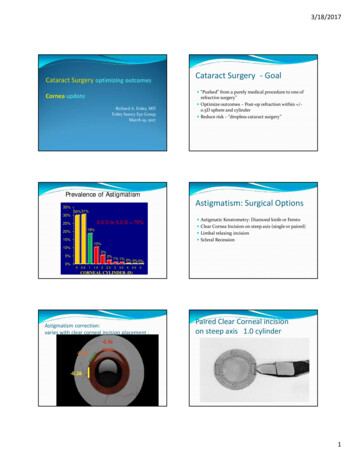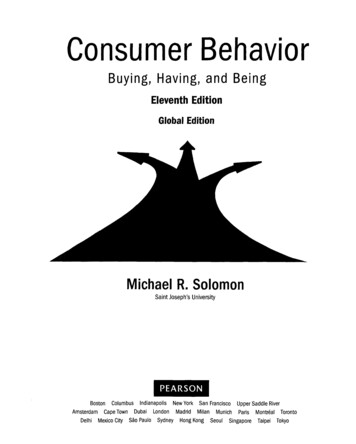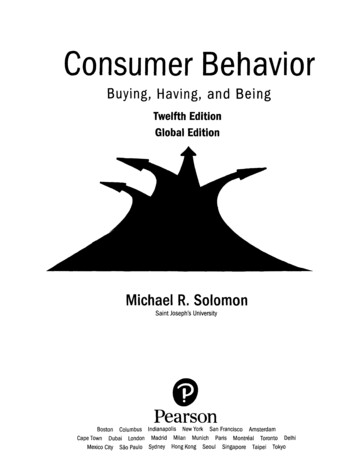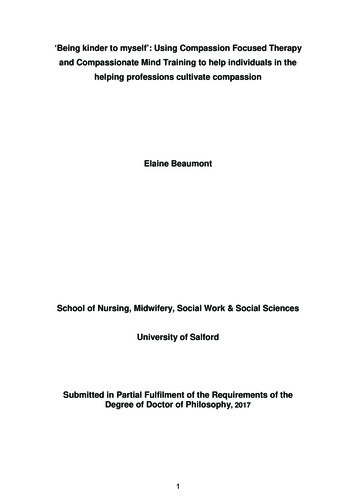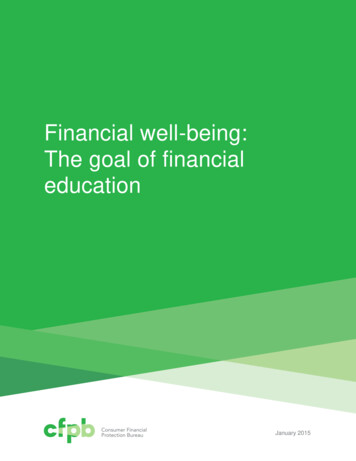
Transcription
Financial well-being:The goal of financialeducationJanuary 2015
Table of contentsTable of contents. 2Executive summary. 41. Introduction . 82. Research design and methods . 122.1 Literature-based research . 132.2 Qualitative research . 162.3 Consultation with a panel of experts . 173. Defining financial well-being . 183.1 What financial well-being is . 183.2 Differences between working-age and older consumer perspectives onfinancial well-being . 214. What influences individual financial well-being. 234.1 Financial behaviors. 244.2 Financial knowledge . 314.3 Personal traits . 374.4 Social and economic environment . 414.5 Life stages . 425. Discussion . 442FINANCIAL WELL-BEING: THE GOAL OF FINANCIAL EDUCATION
5.1 Implications for financial capability practitioners. 455.2 Implications for research. 473FINANCIAL WELL-BEING: THE GOAL OF FINANCIAL EDUCATION
Executive summaryConsumers of financial products and services need both a safe, transparent marketplace, andthe financial capability to navigate that marketplace effectively. The Consumer FinancialProtection Bureau (CFPB) addresses the first aspect through its supervision, enforcement,rulemaking, and other functions. Helping consumers acquire financial capability is also anintegral part of the CFPB’s consumer financial protection mission, as reflected in numerousprovisions of the Dodd-Frank Wall Street Reform and Consumer Protection Act of 2010. The Actcharges the Bureau with researching, developing, promoting, and implementing financialliteracy programs and activities.1In this report we describe our initial research – conducted with a team of expert researchers2 –into how people acquire financial capability, which we undertook specifically to inform financialeducation and improve consumer outcomes. Our overarching objective is to determine how todefine and measure the success of different financial literacy strategies so that we have a basisfor measuring different strategies’ effectiveness. And for this, we need to define the end goal offinancial education.A growing consensus is emerging that the ultimate measure of success for financial literacyefforts should be improvement in individual financial well-being. But financial well-being has1An important financial literacy mandate is set forth in Section 1013(d) of the Dodd-Frank Act, which directs theBureau, through its Office of Financial Education, to develop and implement initiatives intended to “educate andempower consumers to make better informed financial decisions” and to “develop and implement a strategy toimprove the financial literacy of consumers.” (12 U.S.C. § 5493(d)(1)&(2)). The Dodd-Frank Act also mandated thecreation of other offices within the Bureau that are responsible for, among other things, developing financialeducation and policy initiatives to support the financial well-being of particular segments of the consumer population(12 U.S.C. § 5493(b),(e),(g)).2 The research team responsible for conducting the research and analysis described in this report includes Bureaustaff as well as a team of research contractors led by the Corporation for Enterprise Development (CFED), includingthe University of Wisconsin-Madison Center for Financial Security, the Urban Institute, ICF International, and VectorPsychometrics.4FINANCIAL WELL-BEING: THE GOAL OF FINANCIAL EDUCATION
never been explicitly defined, nor is there a standard way to measure it. Overall, the literaturepaints a picture of nuanced, complex interactions between financial knowledge, understanding,and actions taken. However, rigorously identified links between these factors and financialoutcomes have yet to be established.Our project provides a conceptual framework for defining and measuring success in financialeducation by delivering a proposed definition of financial well-being, and insight into the factorsthat contribute to it. This framework is grounded in the existing literature, expert opinion, andthe experiences and voice of the consumer garnered through in-depth, one-on-one interviewswith working-age and older consumers.Financial well-beingThe definition of financial well-being that we propose is based on the consumer perspectiverevealed by the nearly 60 hours of open-ended interviews our research team conducted. Ourresearch suggests financial well-being can be defined as a state of being wherein you: Have control over day-to-day, month-to-month finances; Have the capacity to absorb a financial shock; Are on track to meet your financial goals; and Have the financial freedom to make the choices that allow you to enjoy life.Because individuals value different things, traditional measures such as income or net worth,while important, do not necessarily or fully capture this last aspect of financial well-being.We then sought to identify the specific types of knowledge, behavior, and personal traits thathelp people achieve greater financial well-being. Our research focused on those personal driversof well-being that may be influenced by financial education and other decision-making supports.Of course many factors beyond an individual’s control play a significant role in financialoutcomes, but our research asks, “Given people’s current financial circumstances, how can theymake the best of their situation?”The hypotheses we propose about key drivers of financial well-being were developed bysynthesizing three methodologies in this project—literature reviews, consumer and financialpractitioner interviews, and ongoing and iterative consultation with an expert panel. The5FINANCIAL WELL-BEING: THE GOAL OF FINANCIAL EDUCATION
hypotheses fall into three categories: financial behaviors, financial knowledge, and personaltraits.Financial behaviorsFour types of behaviors are hypothesized to support financial well-being: Effective routine money management, which encompasses often unconscious habits,intuitions, and decision-making shortcuts (heuristics); Financial research and knowledge-seeking, which support purposeful, informed financialdecision-making; Financial planning and goal-setting, which give purpose and structure to individualfinancial decisions; and Following through on financial decisions, the final step between intentions and desiredoutcomes.In other words, our research suggests that people have higher levels of financial well-being whenthey Ask, Plan, and Act, coupled with a strong habit or tendency to live within their means interms of their day-to-day financial choices.Financial knowledgeIn both published research and our interviewees’ responses, we found that the link betweenknowledge and behavior is always affected by individual characteristics like personality,attitudes, and non-cognitive skills, and by context. Our primary hypothesis about the type ofknowledge that supports financial well-being is a set of skills we call “financial ability,” whichencompasses: Knowing when and how to find reliable information to make a financial decision; Knowing how to process financial information to make sound financial decisions; and Knowing how to execute financial decisions, adapting as necessary to stay on track.A growing consensus points toward this notion of financial ability: that in addition to aknowledge component, financial literacy has an action component—that is, the ability or skills toput financial knowledge to use.6FINANCIAL WELL-BEING: THE GOAL OF FINANCIAL EDUCATION
Personal traitsPersonal attitudes and beliefs, non-cognitive skills, and personality traits all influence financialbehavior and play a role in mediating the connection between knowledge and behavior. Basedon our research, we hypothesize that the following four types of personal traits are likely toaffect financial well-being through their influence on behavior and/or preferences andexpectations: Comparing yourself to your own standards, not to others (internal frame of reference); Being highly motived to stay on track in the face of obstacles (perseverance); Having a tendency to plan for the future, control impulses, and think creatively toaddress unexpected challenges (executive functioning); and Believing in your ability to influence your financial outcomes (financial self-efficacy).DiscussionTaken together, this set of hypotheses suggests how particular behaviors, skills, and traitsappear to support or predict financial well-being, given a certain level of opportunity. Thissuggests fascinating possibilities for meaningful research into approaches that could powerfullyenable individuals to achieve and maintain financial well-being.The CFPB seeks to use this research to engage with the financial education field towardcollectively establishing a set of best practices in financial literacy and capability that aregrounded in evidence-based research and able to make a difference in consumers’ lives. Usingthe findings of the research reported here, the CFPB is committed to furthering its consumerfinancial literacy mission through fostering approaches grounded in an understanding offinancial well-being as a key measure of effective financial education. This work presents aunique opportunity to move consumer financial capability practices forward.7FINANCIAL WELL-BEING: THE GOAL OF FINANCIAL EDUCATION
1. IntroductionAn essential part of the mission of the Consumer Financial Protection Bureau (CFPB or Bureau)is empowering consumers to take control over their financial lives. In addition to needing a safe,transparent marketplace, which we address through our supervision, enforcement, rulemaking,and other functions, consumers need the financial capability3 to navigate that marketplaceeffectively to serve their own life goals. This aspect of our mission is reflected in numerousprovisions of the Dodd-Frank Wall Street Reform and Consumer Protection Act of 2010 (DoddFrank Act) that charge the Bureau with researching, developing, promoting, and implementingfinancial literacy programs and activities.4Fulfilling this aspect of our mission requires that we know what approaches are effective inpromoting financial literacy and capability. According to a 2011 Government AccountabilityOffice (GAO) report on financial literacy, “[r]elatively few evidence-based evaluations offinancial literacy programs have been conducted, limiting what is known about which specificmethods and strategies are most effective.”5 The CFPB is taking up this challenge to providestronger evidence of what works, in order to support and guide efforts to improve the3The charter establishing the President’s Advisory Council on Financial Capability defines financial capability as “thecapacity, based on knowledge, skills and access, to manage financial resources effectively.” rter.pdf (2010) (accessed October 13, 2014).4 An important financial literacy mandate is set forth in Section 1013(d) of the Dodd-Frank Act, which directs theBureau, through its Office of Financial Education, to develop and implement initiatives intended to “educate andempower consumers to make better informed financial decisions” and to “develop and implement a strategy toimprove the financial literacy of consumers . . . consistent with the National Strategy for Financial Literacy . . .” (12U.S.C. § 5493(d)(1)&(2)). The Dodd-Frank Act also mandated the creation of other offices within the Bureau that areresponsible for, among other things, developing financial education and policy initiatives to support the financialwell-being of particular segments of the consumer population (12 U.S.C. § 5493(b),(e),(g)).5 U.S. Government Accountability Office. “Financial Literacy: A Federal Certification Process for Providers WouldPose Challenges.” GAO-11-614. http://www.gao.gov/assets/330/320214.pdf (2011) (accessed October 13, 2014).8FINANCIAL WELL-BEING: THE GOAL OF FINANCIAL EDUCATION
effectiveness and quality of financial education, and therefore improve consumers’ financialdecision making to achieve their life goals.6A foundational step is a well-grounded way to define success for financial literacy initiatives.Reaching the goal of consumers making better informed decisions requires identifyingeducational and informational strategies that can change consumer behavior in the marketplacein ways that help them achieve their life goals—not merely improve their knowledge of financialfacts in a classroom. A major task for the CFPB is therefore determining how to define andmeasure the success of different financial lite
Financial planning and goal-setting, which give purpose and structure to individual financial decisions; and Following through on financial decisions, the final step between intentions and desired outcomes. In other words, our research suggests that people have higher levels of financial well-being when they Ask, Plan, and Act, coupled with a strong habit or tendency to live within their means .
